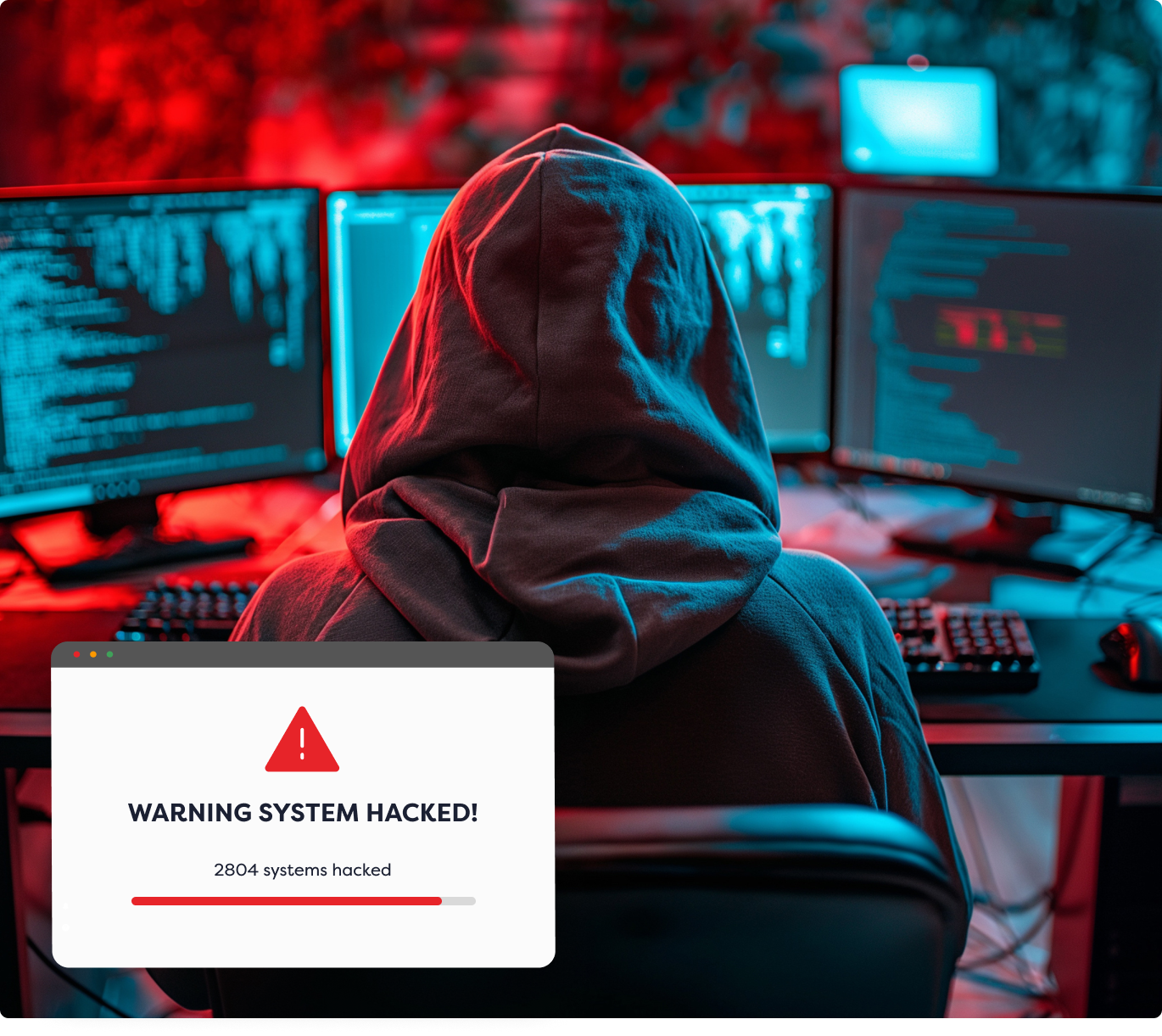Breach and Attack Simulation (BAS)
In an era where cyber threats constantly evolve and security breaches become increasingly sophisticated, safeguarding your organization’s digital assets is paramount.

Join 1,000+ leading companies who trust Rootshell Security
What is Breach and Attack Simulation (BAS)?
Breach and attack simulation is a revolutionary approach in cybersecurity. It allows security teams to conduct continuous, automated simulated attacks that mimic real-world cyber threats. This proactive method helps in identifying vulnerabilities in your security infrastructure before they are exploited.
How does BAS Work?
BAS tools and software simulate a variety of attack techniques against your network. These simulations provide a realistic assessment of how well your security controls and systems can withstand an attack.
Rootshell Security’s breach and attack simulation (BAS) service offers an innovative and dynamic approach to strengthen your security posture. This state-of-the-art BAS solution enables security teams to stay ahead of potential threats by simulating a wide array of cyber attacks in a controlled environment.
At the heart of our service lies our powerful Red Team that meticulously replicates real-world attack scenarios. From data exfiltration to lateral movement, our simulations cover every conceivable angle of a cyber intrusion.
This comprehensive approach ensures that your security controls are not just tested, but rigorously challenged, uncovering hidden vulnerabilities and areas of potential improvement.
BAS tools are designed to mimic the tactics and techniques of modern attackers, offering a realistic assessment of how your network’s security infrastructure would fare in the event of an actual breach. By continuously testing and validating your defences against a diverse range of attack simulations, BAS services play a crucial role in fortifying your cybersecurity measures.
Rootshell Security understands the critical importance of maintaining a robust security posture in the face of ever-changing threat landscapes. Our BAS software, team and tools are not just about identifying weaknesses; they provide invaluable insights into enhancing your overall security operations.
Through strategic simulations and thorough risk assessments, we empower your security team to develop an adaptive and resilient defense against both current and future cyber threats.
Embrace the power of proactive security with Rootshell Security’s breach and attack simulation. Join the ranks of forward-thinking organizations that have transformed their approach to cybersecurity, turning potential vulnerabilities into fortified defenses.
With Rootshell Security, you’re not just testing your security controls; you’re future proofing your entire security infrastructure.
Why is it important?
In today’s evolving threat landscape, traditional methods of penetration testing and vulnerability scanning are no longer enough. BAS offers a more dynamic and comprehensive approach to testing and strengthening your security posture.
Proactive Security Measures
Traditional reactive security approaches are no longer sufficient in the face of advanced cyber attacks. BAS enables security teams to adopt a proactive stance, identifying and addressing vulnerabilities before they can be exploited by malicious actors. This shift from reactive to proactive defence is crucial in today’s threat landscape.
Comprehensive Risk Assessment
BAS provides a thorough evaluation of an organization’s security controls and infrastructure. By simulating real-world attacks, tools reveal hidden weaknesses, offering a comprehensive view of the organization’s security posture and its ability to withstand various cyber threats.
Enhanced Incident Response
Security teams gain invaluable experience in handling simulated breaches and attacks, thus enhancing their incident response capabilities. This hands-on experience is critical for developing effective strategies and responses to real-world cybersecurity incidents.
Validation of Security Investments
Organizations invest significantly in cybersecurity solutions and tools. BAS acts as a validation tool, ensuring that these investments are effective and that the security controls are functioning as intended. It provides tangible evidence of the effectiveness (or areas for improvement) of the existing security infrastructure.
Adaptability to Evolving Threats
The cyber threat environment is dynamic, with new vulnerabilities and attack techniques emerging constantly. BAS helps organizations stay ahead by regularly updating simulations and attack scenarios to reflect the latest threats, ensuring that security measures remain robust and adaptable.
Empowering Security Teams
Empower security teams with deeper insights and understanding of potential attacks and breaches. This knowledge is pivotal in crafting robust security strategies and techniques, enhancing the overall security operations and preparedness of the organization.
Regulatory Compliance
Many industries are subject to stringent cybersecurity regulations. BAS plays a key role in ensuring compliance by regularly testing and proving the effectiveness of security controls against prescribed standards, thereby mitigating risk and avoiding potential legal and financial repercussions.

Benefits of an Automated Breach and Attack Simulation
Continuous testing of security controls
Regular and automated testing ensures consistent security.
Integration of the MITRE ATT&CK framework
Aligns simulations with the latest threat intelligence.
Actionable results and mitigation suggestion
Provides insights for improving security operations.
Hear why the world’s top companies trust us for external penetrating testing

Boost your cybersecurity with penetration testing
Breach Simulation tools
Gartner defines Breach and Attack Simulation tools as ‘tools to enable organizations to gain a deeper understanding of security posture vulnerabilities by automating testing of threat vectors such as external and insider, lateral movement, and data exfiltration.
BAS complements red teaming and penetration testing but cannot completely replace them. BAS validates an organization’s security posture by testing its ability to detect a portfolio of simulated attacks performed by SaaS platforms, software agents, and virtual machines. In addition, it generates detailed reports about security gaps and prioritizes remediation efforts based on the risk level.’
Security Control Validation Using Breach Simulation Tools
Types of attacks that can be simulated with BAS
- Email infiltration attacks
- Malware and ransomware
- Credential-compromised attacks and insider threats
- Exploitation of known vulnerabilities
- APT attack campaigns
- Lateral movement
- Data exfiltration
Types of security controls that can be tested with BAS
- Network security controls
- Endpoint security controls
- Email security controls
- Access control measures
- Vulnerability management policies
- Data security controls
- Incident response controls
Differences between BAS, red teaming, pen testing, and vulnerability scanning
Understanding the distinctions between Breach and Attack Simulation (BAS) and other security techniques like red teaming, penetration testing, and vulnerability scanning is crucial for organizations to effectively fortify their cybersecurity strategy.
BAS vs. Red Teaming
BAS: Automated, continuous, and scalable, BAS tools simulate a wide range of cyber attacks against an organization’s security infrastructure. These simulations are designed to assess and improve the security posture and response capabilities of security teams in a controlled and repeatable manner.
Red Teaming: In contrast, red teaming involves a group of security experts (the red team) attempting to breach an organization’s defences using real-world attacker techniques and strategies. This process is typically manual, less frequent, and focuses on testing the organization’s detection and response capabilities, rather than continuously assessing security controls.
BAS vs. Penetration Testing
BAS: Offers a continuous and automated assessment of an organization’s security posture by simulating a wide array of attacks. It focuses on identifying potential vulnerabilities in security controls and providing actionable insights for improvement.
Penetration Testing: Penetration testing, often conducted by external experts, is a point-in-time assessment where testers try to exploit vulnerabilities in an organization’s network, systems, and applications. While valuable, it provides a snapshot of the security posture at a specific moment, rather than offering ongoing assessment and validation. Examples would be phishing assessments or web app testing.
BAS vs. Vulnerability Scanning
BAS: Focuses on simulating real-world attack scenarios to test the effectiveness of security controls and incident response processes. It goes beyond identifying vulnerabilities to demonstrate how those vulnerabilities could be exploited in an attack.
Vulnerability Scanning: This process is automated and designed to identify known vulnerabilities in networks, systems, and applications. While it’s an essential part of cybersecurity, it does not simulate attacks or test the overall effectiveness of security measures.
Securing your digital landscape with Rootshell:
In conclusion, while red teaming, penetration testing, and vulnerability scanning are critical components of a comprehensive cybersecurity strategy, BAS offers a unique value proposition. It provides continuous, automated testing of an organization’s security infrastructure, helping to ensure that security teams are always prepared for the latest cyber threats. Rootshell Security’s BAS solutions integrate seamlessly into your existing security operations, complementing these traditional techniques to create a robust, resilient, and proactive security environment.
